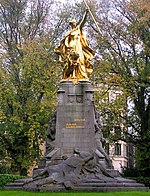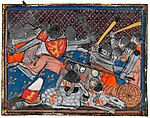The Battle of the Golden Spurs (Dutch: Guldensporenslag; French: Bataille des éperons d'or) was a military confrontation between the royal army of France and rebellious forces of the County of Flanders on 11 July 1302 during the Franco-Flemish War (1297–1305). It took place near the town of Kortrijk (Courtrai) in modern-day Belgium and resulted in an unexpected victory for the Flemish. It is sometimes referred to as the Battle of Courtrai.
On 18 May 1302, after two years of French military occupation and several years of unrest, many cities in Flanders revolted against French rule, and the local militia massacred many Frenchmen in the city of Bruges. King Philip IV of France immediately organized an expedition of 8,000 troops, including 2,500 men-at-arms, under Count Robert II of Artois to put down the rebellion. Meanwhile, 9,400 men from the civic militias of several Flemish cities were assembled to counter the expected French attack.
When the two armies met outside the city of Kortrijk on 11 July, the cavalry charges of the mounted French men-at-arms proved unable to defeat the mail-armoured and well-trained Flemish militia infantry's pike formation. The result was a rout of the French nobles, who suffered heavy losses at the hands of the Flemish. The 500 pairs of spurs that were captured from the French horsemen gave the battle its popular name. The battle was a famous early example of an all-infantry army overcoming an army that depended on the shock attacks of heavy cavalry.
While France was victorious in the overall Franco-Flemish War, the Battle of the Golden Spurs became an important cultural reference point for the Flemish Movement during the 19th and 20th centuries. In 1973, the date of the battle was chosen for the official holiday of the Flemish Community in Belgium.
A 1985 film called De leeuw van Vlaanderen (The Lion of Flanders) shows the battle, and the politics that led up to it.









